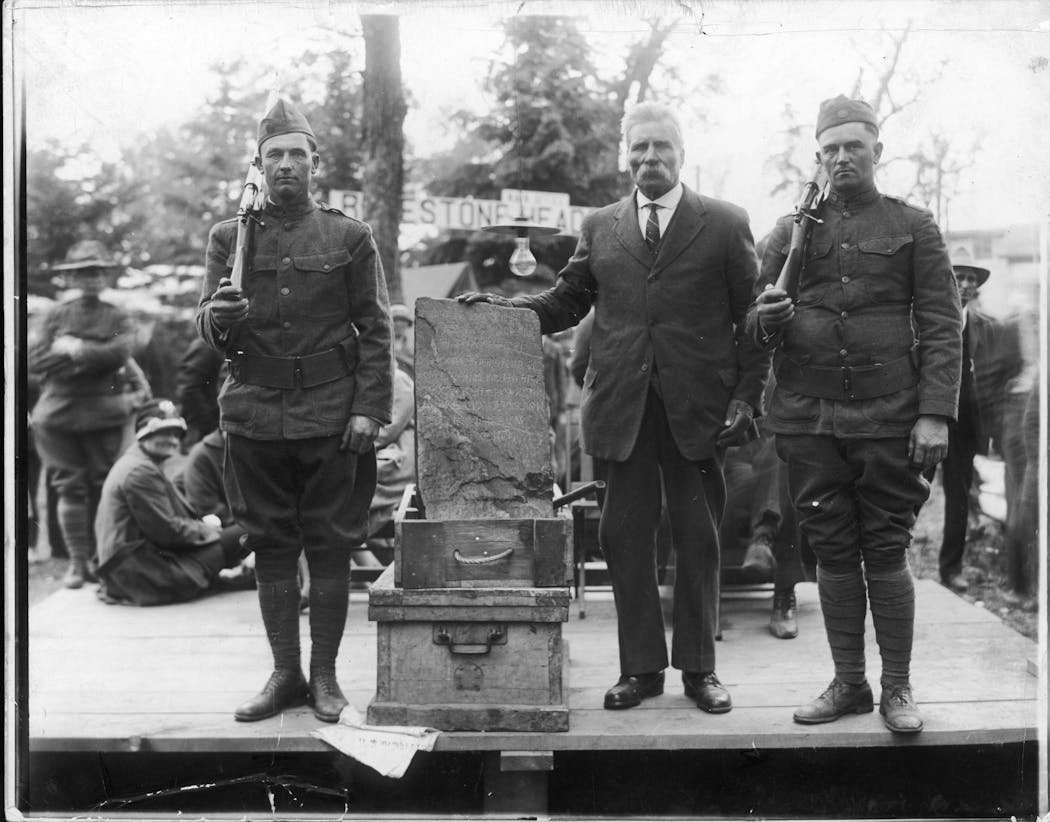What's the truth behind Minnesota's Kensington Runestone?
Listen and subscribe to our podcast: Via Apple Podcasts | Spotify | Stitcher
To this day, visitors leave the Runestone Museum in Alexandria, Minn., unsure of who really carved one of Minnesota's greatest mysteries, the Kensington Runestone.
At the turn of the 20th century, a Swedish farmer in central Minnesota discovered a 202-pound slab of gray sandstone tangled in the roots of a tree. Covered in what appeared to be ancient Germanic letters known as runes, many thought the stone was a relic left by a small group of Nordic explorers as a chronicle of their journey more than 100 years before Christopher Columbus set sail from Spain.
The discovery set off a fierce scholarly debate over the rune stone's authenticity. The lingering mystery behind the artifact led a reader to reach out to the Star Tribune's community-driven reporting project, Curious Minnesota, to ask: "What's the truth behind Minnesota's Kensington Runestone?"
After Swedish immigrant Olof Öhman unearthed the rock on his farm in Kensington in 1898, it immediately became a subject of fascination for geologists, runologists, linguists and fervent Scandinavians.
"Everyone who's very interested in the rune stone is also very passionate about what they believe," said Amanda Seim, executive director at the Runestone Museum. "They tend to be abrasive to people with different ideas."
TThe inscription of Swedish runes on the stone describes the massacre of a group of Norwegians and Swedes in central Minnesota in 1362, over a century before the Niña, Pinta and Santa María came to America.
"The inscription told a really interesting story and that narrative is something that Minnesotans and many European Americans found to be compelling," said David Krueger, a historian and author of a book about the Kensington Runestone. "It appealed to Scandinavian immigrants because this artifact could prove to these newcomers that their ancestors had already come to this land."
Henrik Williams, a professor at Sweden's Uppsala University and one of the world's top authorities on rune stones, said the language on the stone looks like modern Swedish, rather than anything spoken or written in the 1300s.
"The single most compelling piece of evidence that proves the Kensington Runestone to be a 19th century product is the system of runes used, which doesn't occur before late in that century and must be a rather modern development," Williams wrote in an email. "No scientific evidence of any kind supports a 14th century dating."
Nevertheless, the stone raises interesting questions regardless of its authenticity.
For instance, organic material tests revealed the stone had been buried for about 25 years before Öhman found it, suggesting the Swedish farmer may not be a hoaxer, according to Seim.
"It puts the Öhman family back in Sweden, but it doesn't legitimize the stone," she said.
There is a small community that argues the stone is authentic and Öhman's discovery is evidence of early European travelers who made it to the heart of America hundreds of years before the first French explorers arrived. Some say the stone's weathered edges suggest it is more than 200 years old and point to Öhman's grandson, who vehemently denies a possible hoax.
While the identity of the Kensington Runestone's carver remains a mystery, Williams said it should still be approached as a tool for raising further questions.
To that end, the Runestone Museum recently created a 3-D model of the stone that it plans to put on its website for people to study from remote locations.
"It's a very cool artifact but we need to know more about it," Seim said. "We need to do more tests and have an open mind."
---
If you'd like to submit a Curious Minnesota question, fill out the form below:
Read more Curious Minnesota stories:
Is Minnesota actually more German than Scandinavian?
Why are felons stripped of voting rights, and what other rights do they lose?
How did Minnesota's early settlers make it through the dark, cold winters?
Why do we have water towers and what do they do?
Why isn't it a crime to punch someone in the face in pro hockey?
Why does the Stone Arch Bridge cross the river at such an odd angle?
How did Minnesota become the Gopher State?
Why do so many Fortune 500 companies call Minnesota home?



